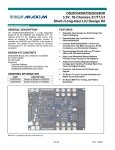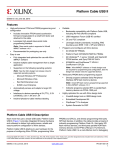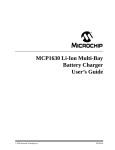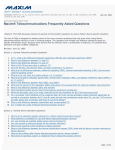Download DS26303DK - Part Number Search
Transcript
DS26303DK 3.3V, E1/T1/J1, Short-Haul, Octal LIU Design Kit www.maxim-ic.com GENERAL DESCRIPTION FEATURES The DS26303DK is a fully integrated design kit for the DS26303 3.3V, 8-port, E1/T1/J1 line interface unit (LIU). This design kit contains all the necessary circuitry to evaluate the DS26303 in all modes of operation. The design kit also includes an on-board microprocessor to run real-time code for further part evaluation. Expedites New Designs by Eliminating FirstPass Prototyping Demonstrates Key Functions of the DS26303 Includes DS26303 x 8-Port LIU, Transformers, 75Ω BNC Connectors, RJ-48 Connectors, and Termination Passives Communicates Directly with any PC with a USB or RS-232 Serial Interface DESIGN KIT CONTENTS DS26303DK Board 5V AC/DC Adapter 3ft USB Cable Download: ChipView Software DS26303DK.def Definition Files DS26303DK Data Sheet High-Level Windows®-Based Software Provides Visual Access to All Registers ORDERING INFORMATION On-Board T1 and E1 Crystal Oscillators for Stable Clock Generation PART DS26303DK Software-Controlled (Register) Mapped Configuration Switches Facilitate Real-Time Clock and Signal Routing Precision Test Points for All Clocks and Signals DESCRIPTION On-Board BERT for Testing and Pattern Generation DS26303 Design Kit Board Windows is a registered trademark of Microsoft Corp. 1 of 43 REV: 101105 DS26303 Design Kit TABLE OF CONTENTS COMPONENT LIST .....................................................................................................................3 BOARD FLOORPLAN.................................................................................................................6 BASIC OPERATION....................................................................................................................7 HARDWARE CONFIGURATION ................................................................................................7 QUICK START (HARDWARE SETTINGS—SINGLE POWER SUPPLY)............................................................... 7 JTAG CONFIGURATION ............................................................................................................................. 7 Table 1. JTAG Connector (J6) Pinout............................................................................................................... 7 Figure 1. DS26303DK JTAG Chain .................................................................................................................. 8 ADDRESS/DATA BUS CONNECTOR ............................................................................................................. 8 Table 2. Address/Data Connector Pinout ......................................................................................................... 8 TELECOM CLOCK AND DATA TEST POINTS ................................................................................................. 9 Table 3. Telecom Connector Pinout ................................................................................................................. 9 ON-BOARD BIT ERROR-RATE TESTER (BERT) .......................................................................................... 9 Table 4. BERT Connector Pinout ..................................................................................................................... 9 PROM SPI CONFIGURATION................................................................................................................... 10 Figure 2. SPI Timing Diagram ........................................................................................................................ 10 Figure 3. SPI Configuration with PROM ......................................................................................................... 11 Table 5. Configuration Memory ...................................................................................................................... 11 SOFTWARE CONFIGURATION ...............................................................................................12 QUICK START (SOFTWARE—CHIPVIEW) .................................................................................................. 12 MEMORY MAP..........................................................................................................................12 Table 6. DS26303DK Relative Address Map.................................................................................................. 12 Table 7. General-Purpose FPGA Memory Map.............................................................................................. 12 ID REGISTERS..........................................................................................................................13 CONTROL REGISTERS............................................................................................................13 DS26303 INFORMATION..........................................................................................................21 DS26303DK INFORMATION.....................................................................................................21 TECHNICAL SUPPORT ............................................................................................................21 SCHEMATICS ...........................................................................................................................21 2 of 43 DS26303 Design Kit COMPONENT LIST DESIGNATION C1, C4, C6, C7, C18, C24, C26, C34, C36, C37, C38, C41, C43– C47, C49, C50, C51, C53–C59, C61–C83, C85, C86, C90 C2, C3, C22, C30, C35, C40, C42, C48, C52, C60, C84, C88, C89 C5, C9, C19, C21, C27, C28, C87 QTY DESCRIPTION SUPPLIER/ PART NUMBER 53 0.1µF ±20%, 16V X7R ceramic capacitors (0603) AVX 0603YC104MAT 13 1µF ±10%, 16V ceramic capacitors (1206) Panasonic ECJ-3YB1C105K 7 10µF ±20%, 10V ceramic capacitors (1206) C8 1 6.8µF ±10%, 6.3V X5R ceramic capacitor (1206) C10–C17 8 470pF ±10%, 100V ceramic capacitors (0603) C20, C23, C25, C91, C92 5 68µF ±20%, 16V tantalum capacitors (D case) C29, C31, C39 3 22pF ±5%, 25V ceramic capacitors (0603) C32, C33 2 10pF ±5%, 50V ceramic capacitors (1206) (tall case) D1, D12 2 Green LEDs (SMD) D2–D11 10 Red LEDs (SMD) D13, D14, D15 3 1A, 40V Schottky diodes H1–H4 4 KIT, 4-40 hardware 0.75 nylon standoff and 0.25 nylon screw J1 1 40-pin terminal strip (dual row, vertical) J2 1 2.1mm/5.5mm connector Power jack, right-angle PC board mount; closed frame, high current, 24V DC at 5A J3 1 Black, single right angle (Type B) J4 1 DB9 right-angle connector (short case) J5, J7, J8, J21–J36 19 5-pin SMB connectors 50Ω, vertical, gold J6, J9–J17 10 14-pin headers (dual row, vertical) J18, J19, J20 3 100-mil 3-position jumpers J37–J44 8 2-pin headers, 0.100in centers (vertical) J45, J46 2 8-pin 4-port RJ45 jacks (right angle) L1 1 1.0µH ±20%, 2-pin SMT inductor 3 of 43 Panasonic ECJ-3YB1A106M Panasonic ECJ-3YB0J685K Panasonic ECJ-1VB2A471K Panasonic ECS-T1CD686R AVX 06033A220JAT Phycomp 1206CG100J9B200 Panasonic LN1351C Panasonic LN1251C International Rectifier 10BQ040 Not applicable 4-40KIT2 Samtec TSW-120-07-T-D CUI, Inc. PJ-002AH Molex Not applicable AMP 788750-2 AMP 413990-1 Samtec TSW-107-14-T-D Samtec Not applicable Samtec TSW-102-07-T-S Molex 43223-8140 Coiltronics UP1B-1R0 DS26303 Design Kit SUPPLIER/ PART NUMBER DESIGNATION QTY DESCRIPTION R1, R58, R87 3 Resistors (0603) DO NOT POPULATE — R2, R14–R26, R28, R32–R43, R46– R50, R52, R54– R57, R63–R66, R68, R69, R71, R72, R73, R76, R77, R82, R85, R86, R88, R91, R93, R96, R97, R130 57 10kΩ ±5%, 1/16W resistors (0603) Panasonic ERJ-3GEYJ103V R3–R9, R11, R12, R13, R29, R31, R44, R45, R60, R61, R62, R78, R79, R94, R95, R98–R102, R104, R117, R120, R121, R124–R129 36 33Ω ±5%, 1/16W resistors (0603) Panasonic ERJ-3GEYJ330V R10 1 22kΩ ±5%, 1/16W resistor (0603) Panasonic ERJ-3GEYJ223V R27, R67, R70, R74, R75, R80, R81, R83, R84, R89, R90, R123 12 330Ω ±5%, 1/16W resistors (0603) Panasonic ERJ-3GEYJ331V R30, R59 2 15kΩ ±5%, 1/16W resistors (0603) Panasonic ERJ-3GEYJ153V R51 1 Resistor (1206) DO NOT POPULATE — R53 1 470Ω ±5%, 1/16W resistor (0603) R92 1 51Ω ±5%, 1/16W resistor (0603) R103, R105–R116, R118, R119, R122 16 60.4Ω ±1%, 1/16W resistors (0603) SW2, SW6 2 4-pin single-pole switch SW3, SW4, SW5, SW7 4 6-pin slide switches (DPDT, through hole) T1, T2 2 U1 1 U2 1 U3, U11 2 U4 1 U5 1 U6 1 Transformers (1:2 count transmitter/1:1 count receiver) (40-pin wide SO, -40°C to +85°C) 8-bit FIFO USB UART (32-pin LQFP) MCORE Microcontroller (144-pin LQFP) 128k x 8 SRAM (32-pin SO) DS2174 EBERT (44-pin PLCC, 0°C to +70°C) Spartan-II 2.5V FPGA, 200k gate (256-pin BGA) 3.3V, E1/T1/J1 long-haul octal LIU (144-pin eLQFP, 0°C to +70°C) 4 of 43 Panasonic ERJ-3GEYJ471V Panasonic ERJ-3GEYJ510V Panasonic ERJ-3EKF60R4V Panasonic EVQPAE04M Tyco Electronics SSA22 Pulse Engineering T1114 FTDI FT245BM Motorola MMC2107PV Cypress CY62128VL-70SC Dallas Semiconductor DS2174Q Xilinx XC2S200-5FG256C Dallas Semiconductor DS26303L DS26303 Design Kit DESIGNATION QTY DESCRIPTION U7 1 U8 1 U9, U12 2 High-speed buffers U10, U18 2 1.5W, 3.3V or adj, 1A linear regulators (16-pin TSSOP-EP) U13, U15 2 Hex inverters (14-pin SO) U14 1 U16 1 U17 1 U19 1 X1 1 6.00MHz low-profile crystal X2 1 8.000MHz low-profile crystal Y1 1 Y2 1 PROM for FPGA (44-pin TQFP) Dual RS-232 transmitter/receiver (150-mil, 16-pin SO) Quad 2-input NAND gate (14-pin SO) Switch debouncer (4-pin SOT143) 2.5V or adj linear regulator (8-pin µMAX/SO) Platform flash in-system programmable configuration PROM (2Mb, 20-pin TSSOP) Oscillator, crystal clock 5V, 2.048MHz Oscillator, crystal clock 5V, 1.544MHz 5 of 43 SUPPLIER/ PART NUMBER Xilinx XC18V02VQ44C Dallas Semiconductor DS232AR Fairchild Semiconductor NC7SZ86 Maxim MAX1793EUE-33 Toshiba TC74HC04AFN Toshiba TC74HC00AFN Maxim MAX6816EUS-T Maxim MAX1792EUA25 Xilinx XCF02SVO20C Pletronics LP49-26-6.00M Ecliptek Corp. EC1-8.000M SaRonix NTH039A-2.0480 SaRonix NTH039A-1.5440 DS26303 Design Kit BOARD FLOORPLAN 5V PWR TECLK CLK A LOS LED TCLK, RCLK, RLOS TPOS, RPOS, TNEG, RNEG CON USER SWITCHES BERT DS2174 BERT ADDRESS/DATA XFMR PORTS 5–8 JTAG SERIAL CON LIU PWR JUMPER CON RJ48 FLASH PROM PORTS 5–8 ON-BOARD µC DS26303 RST BOARD SRAM USB Tx/Rx USB CON USER BNC OSC E1 OSC T1 RJ48 PORTS 1–4 SRAM PORTS 1–4 TCLK, RCLK, RLOS TPOS, RPOS, TNEG, RNEG FPGA Tx/Rx CLOCK, DATA SWITCH/MUX LOS LED 6 of 43 XFMR DS26303 Design Kit BASIC OPERATION This design kit relies upon several supporting files, which are available for downloading on our website at www.maxim-ic.com/DS26303DK. The support files are used with an evaluation program called ChipView, which is available for download at www.maxim-ic.com/telecom. HARDWARE CONFIGURATION Quick Start (Hardware Settings—Single Power Supply) • • • • • • • For single power-supply operation, short jumpers J18, J19, and J20 between the 3.3V pin and the VLIU pin. This connects VDD of the DS26303 to the 3.3V supply on the design kit. Ensure that the FLASH switch (SW3) is in the RUN position. Ensure that the FPGA switch (SW5) is in the ON position. Ensure that the SPI/PROM switch (SW7) is in the OFF position. If using the serial port, connect a RS-232 serial cable from DS26303DK (J4) to the PC. If using the USB port, connect a USB cable from DS26303DK (J3) to the PC. Connect AC/DC adapter with an AC power source and the DS26303DK (J2). PWR LED should be on. JTAG Configuration The JTAG chain is controlled by the connector JTAG CON (J6) and two on-board switches: FLASH (SW3) and ONCE/JTAG (SW4). Depending on the function, such as programming the internal microcontroller flash or performing boundary scan operations, the JTAG CON connector can be used and the switches can be configured to accomplish the desired task. For information on programming the internal flash of the on-board microcontroller, refer to the MMC2107 microcontroller user manual and board schematic. For most purposes, having the complete JTAG chain is sufficient. Figure 1 shows the complete chain as well as what order the devices appear during boundary scan. Table 1 shows the pinout of the JTAG connector. Connect any JTAG cable to the connector to perform all operations. Note the JTAG chain changes depending on the switch SW4. The ONCE location of SW4 is used for programming the on-board microcontroller only. Table 1. JTAG Connector (J6) Pinout PIN NAME 1 2, 4, 6, 7 3 5 8 9 10 11 12 13 14 JTDI GND JTDO JTCLK ALIGN KEY BRD RST JTMS BRD V3.3 JDE N.C. JTRST 7 of 43 DS26303 Design Kit Figure 1. DS26303DK JTAG Chain SW4 JTAG JTMS JTCLK JTDI JTDO (U2) (U19) ON-BOARD µC FLASH MEM FOR FPGA (U5) GEN (U6) DS26303 FPGA ONCE (U7) FLASH MEM FOR SPI SW4 JTMS JTCLK (U2) JTDI JTDO ON-BOARD µC Address/Data Bus Connector The DS26303DK has a connector (J1) to monitor all local bus activity for the design kit. All the signals can be captured with a high-impedance probe and displayed on an oscilloscope or logic analyzer. Note: If the FPGA switch (SW5) is in the “OFF” position, the on-board microcontroller will no longer drive any data onto the local bus. Therefore, the user can now connect the local bus of the DS26303 into another system without making any modifications to the hardware. See Table 2 for specific pin information for connector J1. Table 2. Address/Data Connector Pinout PIN 1 3 5 7 9 11 13 15 17 19 21 23 25 27 29 31 33 35 NAME A8 A7 A6 A5 A4 A3 A2 A1 A0 MUX CSFPGA CSBERT CSLIU ALELIU RD WR MODESEL — FUNCTION Local Address Bit 8 Local Address Bit 7 Local Address Bit 6 Local Address Bit 5 Local Address Bit 4 Local Address Bit 3 Local Address Bit 2 Local Address Bit 1 Local Address Bit 0 Mux Chip Select FPGA Chip Select DS2174 Chip Select DS26303 Address Latch Enable Read Signal Write Signal Mode Select Not Used PIN 2 4 6 8 10 12 14 16 18 20 22 24 26 28 30 32 34, 36 37–40 8 of 43 NAME D0 D1 D2 D3 D4 D5 D6 D7 CLKE RDY OE MOTEL INT FPGAEN UIN1 UIN2 3.3V GND FUNCTION Local Data Bit 0 Local Data Bit 1 Local Data Bit 2 Local Data Bit 3 Local Data Bit 4 Local Data Bit 5 Local Data Bit 6 Local Data Bit 7 SPI Clock Edge Select Ready Handshake from LIU Output Enable LIU Motorola/Intel Select Interrupt for DS26303 FPGA Enable Pin User Input 1 User Input 2 Board 3.3V Ground DS26303 Design Kit Telecom Clock and Data Test Points The DS26303DK has high-impedance test points for all the telecom signals that are related to the LIU. These signals are split up by port number and marked with easy to read silkscreen labels. Table 3 shows the telecom connector for port 1. The pinout for this connector is repeated for all 8 ports. Table 3. Telecom Connector Pinout PIN 1 2, 4, 6, 8, 10, 12, 14 3 5 7 9 11 13 NAME TCLK GND RCLK TPOS RPOS TNEG RNEG RLOS FUNCTION Transmit Clock Input Ground Receive Clock Output Transmit Positive Data Input Receive Positive Data Output Transmit Negative Data Input Receive Positive Data Output Receive Loss-of-Signal Output Note that the input signals in the telecom connector go from the connector to the on-board FPGA, then to the DS26303. The FPGA was designed to perform specific signal routing functions such as looping back RPOS to TPOS on a particular port or transferring data from the on-board BERT. If you are using user-defined data and drive the signal on the connector, be sure to tri-state the input signal in the FPGA. FAILURE TO DO SO COULD CAUSE DAMAGE TO THE FPGA! On-Board Bit Error-Rate Tester (BERT) The DS26303DK has an on-board bit error-rate tester (BERT) to generate and detect errors in either pseudorandom or user-defined patterns. The BERT on the DS26303DK is the DS2174. A header for the relevant signals related to the BERT is located on the board (J17). See Table 4 for the pinout of the BERT connector. The BERT signals are routed into the FPGA and can be muxed into any of the 8 DS26303 LIU ports under software control. For all questions concerning the operation of the on-board BERT, refer to the device data sheet available online at www.maxim-ic.com/telecom. If you are using user-defined data and driver the signal on the connector, be sure to tri-state the input signal in the FPGA. FAILURE TO DO SO COULD CAUSE DAMAGE TO THE FPGA! Table 4. BERT Connector Pinout PIN 1 2, 4, 6, 8, 10, 12, 14 3 5 7 9 11 13 NAME TCLK_EN GND TCLKIN TCLKO RCLKIN RCLKEN TDAT RDAT FUNCTION BERT TCLK Enable Ground BERT TCLK Input BERT TCLK Output BERT RCLK Input BERT RCLK Enable BERT TDAT Output BERT RDAT Input 9 of 43 DS26303 Design Kit PROM SPI Configuration In software mode, it is possible to configure the DS26303 using a parallel interface or a serial peripheral interface (SPI). Most advanced microcontrollers have both a parallel interface and SPI interface such as the microcontroller on the DS26303DK. The command you send to the microcontroller through either the USB or serial port determines if that data is placed on the parallel or SPI bus. Refer to the data sheet for Chipview on the particular commands required to switch data ports. A unique feature with the SPI port is that a PROM can be used to provide the LIU with the specific data needed for configuration. If the data in the PROM is formatted a certain way, it can seem as the PROM is acting like a controller with a SPI interface in master mode. The most common PROMs to use for this type of application are those with an internal address accumulator. This feature for the PROM is important because the device must automatically jump to the next available address in the configuration memory. The Xilinx XC18V00 device family is a byte-wide nonvolatile memory with an autoincrement address function. The family of devices is available in 1Mb, 2Mb, and 4Mb densities. The PROM is also useful because the device can perform in-circuit programming with the JTAG port. Refer the data sheet for the XC18V00 for the JTAG codes for programming the configuration memory. Figure 2 shows a general relationship of the timing for a SPI bus. For this case, all data is clocked into the slave device on the rising edge of SCLK. This feature can be configurable on the DS26303. Figure 2. SPI Timing Diagram SCLK 1 2 3 4 5 6 7 A1 A2 A3 A4 A5 A 6 8 9 10 11 12 13 14 15 16 D4 D5 D6 D7 CSB SDI 0 (lsb) x DO (adrs msb) (lsb) D1 D2 D3 (msb) WRITE ACCESS ENABLED SDO Figure 3 shows a simplified diagram of the XC18V00 device and the DS26303 in SPI (serial) mode. Notice a few key points about this diagram. First, the CLK for the XC18V00 is the MCLK for the LIU, but this is not the SCLK for the SPI interface. The SCLK can be programmed as needed. See Table 5 for an example of the memory map. Second, the programming for this device begins when OE on the XC18V00 goes high. Therefore, consideration must be taken if some delay is necessary. Generally, it is sufficient for the OE pin to be connected to some powerup delay device. The OE delay is not necessary on this DK. 10 of 43 DS26303 Design Kit Figure 3. SPI Configuration with PROM (U12) JTCLK JTMS JTDI JTDO (U6) XC18V00 CFG PROM 3.3V D7 CS D6 SCLK D5 SDI DS26303 CE OE CLK DELAY MCLK (LIU) Table 5. Configuration Memory ADDRESS 0x00 0x01 0x02 0x03 0x04 0x05 0x06 0x07 0x08 0x09 0x0A 0x0B 0x0C 0x0D 0x0E 0x0F 0x10 0x11 0x12 0x13 0x14 0x15 0x16 0x17 0x18 0x19 0x1A 0x1B 0x1C 0x1D 0x1E 0x1F 0x20 0x21 0x22 D7 CSB 1 0 0 0 0 0 0 0 0 0 0 0 0 0 0 0 0 0 0 0 0 0 0 0 0 0 0 0 0 0 0 0 0 1 1 D6 SCLK 0 0 1 0 1 0 1 0 1 0 1 0 1 0 1 0 1 0 1 0 1 0 1 0 1 0 1 0 1 0 1 0 1 0 X D5 SDI 0 0 0 1 1 0 0 0 0 0 0 0 0 0 0 0 0 0 0 1 1 1 1 0 0 0 0 1 1 1 1 0 0 X X D4 X D3 D2 D1 X X X Start of Write Cycle Bit A0 (Always a “0” for a write) Bit A1 Bit A2 Bit A3 Bit A4 Bit A5 Bit A6 Bit A7 Bit D0 (LSB) Bit D1 Bit D2 Bit D3 Bit D4 Bit D5 Bit D6 Bit D7 End of Write Cycle 11 of 43 D0 X DS26303 Design Kit SOFTWARE CONFIGURATION Quick Start (Software—ChipView) • • • • • • • • Perform steps in the Quick Start (Hardware Configuration). Load ChipView software. Select COM port. Select Register View. From the Programs menu, launch the host application named ChipView.exe. If the default installation options were used, click the Start button on the Windows toolbar and select Programs -> ChipView -> ChipView. Load the DS26303DK.def file. Make sure that all the register settings are correct for the proper function desired for the DS26303DK. Refer to the DS26303 data sheet for all questions pertaining to device functionality. MEMORY MAP The on-board microcontroller is configured to start the user address space at 0x81000000. All offsets given below are relative to the beginning of the user address space. Table 6. DS26303DK Relative Address Map REF DES U5 U4 U6 DEVICE General-Purpose FPGA Tx/Rx Clock, Data Switch/Mux DS2174 BERT DS26303 8-Port T1/E1/J1 LIU OFFSET 0x0000 0x1000 0x2000 All device registers can be easily modified using the ChipView.exe host-based user-interface software. Table 7. General-Purpose FPGA Memory Map OFFSET REGISTER NAME TYPE 0x00 0x02 0x03 0x04 0x05 0x06 0x07 0x08 0x0A 0x0B 0x0C 0x0D 0x10 0x11 0x12 BRDID DSIDH DSIDM DSIDL BRDREV ASMREV FPGAREV CTRL1 ABSP BTCLK BRCLK BRDAT TCLK TPOS TNEG Read-Only Read-Only Read-Only Read-Only Read-Only Read-Only Read-Only Control Control Control Control Control Control Control Control DESCRIPTION Board ID Dallas Extended ID Upper Nibble Dallas Extended ID Middle Nibble Dallas Extended ID Lower Nibble Board Rev Assembly Rev FPGA Firmware Rev Control Register 1 Address Bank Select Pointer BERT TCLK Input BERT RCLK Input BERT RDAT Input Indirect Register for TCLK Source Control Indirect Register for TPOS Source Control Indirect Register for TPOS Source Control 12 of 43 DS26303 Design Kit ID REGISTERS BID: BOARD ID (Offset = 0X0000) BID is read-only with a value of 0xD. XBIDH: HIGH NIBBLE EXTENDED BOARD ID (Offset = 0X0002) XBIDH is read-only with a value of 0x0. XBIDM: MIDDLE NIBBLE EXTENDED BOARD ID (Offset = 0X0003) XBIDM is read-only with a value of 0x1. XBIDL: LOW NIBBLE EXTENDED BOARD ID (Offset = 0X0004) XBIDL is read-only with a value of 0x6. BREV: BOARD FAB REVISION (Offset = 0X0005) BREV is read-only and displays the current fab revision. AREV: BOARD ASSEMBLY REVISION (Offset = 0X0006) AREV is read-only and displays the current assembly revision. PREV: FPGA REVISION (Offset = 0X0007) PREV is read-only and displays the current PLD firmware revision. CONTROL REGISTERS Register Name: CTRL_1 Register Description: DS26303DK FPGA CONTROL REGISTER 1 Register Offset: 0x08 Bit # Name 7 INT303 6 ENRLOS1 5 CLKE 4 SPI_SWAP 3 SPI 2 OE 1 MCLK1 0 MCLK0 Bit 7: INT303. This bit indicates the status of the INT303 line. If INT303 = LOW, there is no hardware interrupt on the DS26303. If INT303 = HIGH, there is a hardware interrupt on the DS26303. Bit 6: ENRLOS1. This bit enables the RLOS1 LED. This should not be enabled when driving TECLK from the DS26303. If ENRLOS1 = LOW, the RLOS1 LED is not enabled. If ENRLOS1 = HIGH, the RLOS1 LED is enabled and lights when RLOS1 is high. Bit 5: CLKE. This bit sets the CLKE pin on the DS26303. This is only active when SPI (Bit 0) is HIGH. If SPI (Bit 0) is low, CLKE is always low. If CLKE = LOW, SDO is clocked out on the rising edge of SCLK. If CLKE = HIGH, SDO is clocked out on the falling edge of SCLK. Bit 4: SPI_SWAP. This bit sets the BSWP/A5 pin on the DS26303. This is only active when SPI (Bit 0) is HIGH. If SPI_SWAP = LOW, the SPI bus is LSB first. If SPI_SWAP = HIGH, the SPI bus is MSB first. Bit 3: SPI. This bit sets up the FPGA to use serial mode. This bit also changes the mode pin on the DS26303. If SPI = LOW, the parallel bus is used for all read/write access. This also sets the MODE pin on the DS26303 to logic 1. If SPI = HIGH, the SPI bus is used for all read/write access. This also sets the MODE pin on the DS26303 to logic 0. Bit 2: OE. This bit controls the OE pin to the DS26303. Bits 1 and 0: MCLK1 and MCLK0. These bits control the MCLK pin to the DS26303. MCLK1 MCLK0 DESCRIPTION OF MCLK 0 0 MCLK = high-impedance mode 0 1 MCLK = on-board T1 oscillator 1 0 MCLK = on-board E1 oscillator 1 1 MCLK = user clock input 13 of 43 DS26303 Design Kit Register Name: ABSP Register Description: ADDRESS BANK SWAP POINTER Register Offset: 0x0A Bit # Name 7 D7 6 D6 5 D5 4 D4 3 D3 2 D2 1 D1 0 D0 Bits 7 to 0: D7 to D0. These bits control the address bank for address 0x10 (TCLK N), 0x11 (TPOS), and 0x12 (TNEG). ABSP 0x00 0x01 0x02 0x03 0x04 0x05 0x06 0x07 DESCRIPTION Bank Address Value for Port 1 Bank Address Value for Port 2 Bank Address Value for Port 3 Bank Address Value for Port 4 Bank Address Value for Port 5 Bank Address Value for Port 6 Bank Address Value for Port 7 Bank Address Value for Port 8 14 of 43 DS26303 Design Kit Register Name: BTCLK Register Description: BERT TCLK SOURCE Register Offset: 0x0B Bit # Name 7 D7 6 D6 5 D5 4 D4 3 D3 Bits 7 to 0: D7 to D0. These bits control the source of the TCLK for the BERT. BTCLK 0x00 0x01 0x02 0x03 0x04 0x05 0x06 0x07 0x08 0x09 0x0A 0x0B 0x0C 0x0D 0x0E 0x0F 0x10 0x11 0x12 0x13 0x14 0x15 0x16–0xFF DESCRIPTION RCLK Port 1 RCLK Port 2 RCLK Port 3 RCLK Port 4 RCLK Port 5 RCLK Port 6 RCLK Port 7 RCLK Port 8 HI-Z HI-Z HI-Z HI-Z HI-Z HI-Z HI-Z HI-Z 1.544MHz On-board oscillator 2.048MHz On-board oscillator User clock CLKA DS26303 TECLK DS26303 TCLKBERT OUT HI-Z 15 of 43 2 D2 1 D1 0 D0 DS26303 Design Kit Register Name: BRCLK Register Description: BERT RCLK SOURCE Register Offset: 0x0C Bit # Name 7 D7 6 D6 5 D5 4 D4 3 D3 Bits 7 to 0: D7 to D0. These bits control the source of the RCLK for the BERT. BTCLK 0x00 0x01 0x02 0x03 0x04 0x05 0x06 0x07 0x08 0x09 0x0A 0x0B 0x0C 0x0D 0x0E 0x0F 0x10 0x11 0x12 0x13 0x14 0x15 0x16–0xFF DESCRIPTION RCLK Port 1 RCLK Port 2 RCLK Port 3 RCLK Port 4 RCLK Port 5 RCLK Port 6 RCLK Port 7 RCLK Port 8 HI-Z HI-Z HI-Z HI-Z HI-Z HI-Z HI-Z HI-Z 1.544MHz On-board oscillator 2.048MHz On-board oscillator User clock CLKA DS26303 TECLK DS26303 TCLKBERT OUT HI-Z 16 of 43 2 D2 1 D1 0 D0 DS26303 Design Kit Register Name: BRDAT Register Description: BERT RDAT SOURCE Register Offset: 0x0D Bit # Name 7 D7 6 D6 5 D5 4 D4 3 D3 2 D2 1 D1 0 D0 Bits 7 to 0: D7 to D0. These bits control the source of the RDAT for the BERT. Note that the DS26303 must be in single-rail mode for BERT to function properly. BRDAT 0x00 0x01 0x02 0x03 0x04 0x05 0x06 0x07 0x08 0x09 0x0A 0x0B 0x0C 0x0D 0x0E 0x0F 0x10 0x11 0x12 0x13 0x14 0x15 0x16–0xFF DESCRIPTION RPOS Port 1 RPOS Port 2 RPOS Port 3 RPOS Port 4 RPOS Port 5 RPOS Port 6 RPOS Port 7 RPOS Port 8 HI-Z HI-Z HI-Z HI-Z HI-Z HI-Z HI-Z HI-Z 1.544MHz On-board oscillator 2.048MHz On-board oscillator User clock CLKA DS26303 TECLK DS26303 TCLKBERT OUT HI-Z 17 of 43 DS26303 Design Kit Register Name: TCLK Register Description: PORT TCLK SOURCE Register Offset: 0x10 Bit # Name 7 D7 6 D6 5 D5 4 D4 3 D3 2 D2 Note: This is an indirect register that is related to ABSP (0x0A). See register description. Bits 7 to 0: D7 to D0. These bits control the source of the port TCLK for the DS26303. TCLK 0x00 0x01 0x02 0x03 0x04 0x05 0x06 0x07 0x08 0x09 0x0A 0x0B 0x0C 0x0D 0x0E 0x0F 0x10 0x11 0x12 0x13 0x14 0x15 0x16–0xFF DESCRIPTION RCLK Port 1 RCLK Port 2 RCLK Port 3 RCLK Port 4 RCLK Port 5 RCLK Port 6 RCLK Port 7 RCLK Port 8 HI-Z HI-Z HI-Z HI-Z HI-Z HI-Z HI-Z HI-Z 1.544MHz On-board oscillator 2.048MHz On-board oscillator User clock CLKA DS26303 TECLK DS26303 TCLKBERT OUT HI-Z 18 of 43 1 D1 0 D0 DS26303 Design Kit Register Name: TPOS Register Description: PORT TPOS SOURCE Register Offset: 0x11 Bit # Name 7 D7 6 D6 5 D5 4 D4 3 D3 2 D2 Note: This is an indirect register that is related to ABSP (0x0A). See register description. Bits 7 to 0: D7 to D0. These bits control the source of the port TPOS for the DS26303. TPOS 0x00 0x01 0x02 0x03 0x04 0x05 0x06 0x07 0x08 0x09 0x0A 0x0B 0x0C 0x0D 0x0E 0x0F 0x10 0x11 0x12 0x13 0x14 0x15 0x16–0xFF DESCRIPTION RPOS Port 1 RPOS Port 2 RPOS Port 3 RPOS Port 4 RPOS Port 5 RPOS Port 6 RPOS Port 7 RPOS Port 8 HI-Z HI-Z HI-Z HI-Z HI-Z HI-Z HI-Z HI-Z 1.544MHz On-board oscillator 2.048MHz On-board oscillator User clock CLKA DS26303 TECLK DS26303 TDATBERT OUT HI-Z 19 of 43 1 D1 0 D0 DS26303 Design Kit Register Name: TNEG Register Description: PORT TNEG SOURCE Register Offset: 0x12 Bit # Name 7 D7 6 D6 5 D5 4 D4 3 D3 2 D2 Note: This is an indirect register that is related to ABSP (0x0A). See register description. Bits 7 to 0: D7 to D0. These bits control the source of the port TNEG for the DS26303. TNEG 0x00 0x01 0x02 0x03 0x04 0x05 0x06 0x07 0x08 0x09 0x0A 0x0B 0x0C 0x0D 0x0E 0x0F 0x10 0x11 0x12 0x13 0x14 0x15 0x16–0xFF DESCRIPTION RNEG Port 1 RNEG Port 2 RNEG Port 3 RNEG Port 4 RNEG Port 5 RNEG Port 6 RNEG Port 7 RNEG Port 8 HI-Z HI-Z HI-Z HI-Z HI-Z HI-Z HI-Z HI-Z 1.544MHz On-board oscillator 2.048MHz On-board oscillator User clock CLKA DS26303 TECLK DS26303 Drive Logic “0” HI-Z 20 of 43 1 D1 0 D0 DS26303 Design Kit DS26303 INFORMATION For more information about the DS26303, refer to the DS26303 data sheet available on our website at www.maxim-ic.com/DS26303. DS26303DK INFORMATION For more information about the DS26303DK including software downloads, go to www.maxim-ic.com/DS26303DK. TECHNICAL SUPPORT For additional technical support, e-mail your questions to [email protected]. SCHEMATICS The DS26303DK schematics are featured in the following 22 pages. 21 of 43 Maxim/Dallas Semiconductor cannot assume responsibility for use of any circuitry other than circuitry entirely embodied in a Maxim/Dallas Semiconductor product. No circuit patent licenses are implied. Maxim/Dallas Semiconductor reserves the right to change the circuitry and specifications without notice at any time. Maxim Integrated Products, 120 San Gabriel Drive, Sunnyvale, CA 94086 408-737-7600 © 2005 Maxim Integrated Products • Printed USA The Maxim logo is a registered trademark of Maxim Integrated Products, Inc. The Dallas logo is a registered trademark of Dallas Semiconductor Corporation.
























































